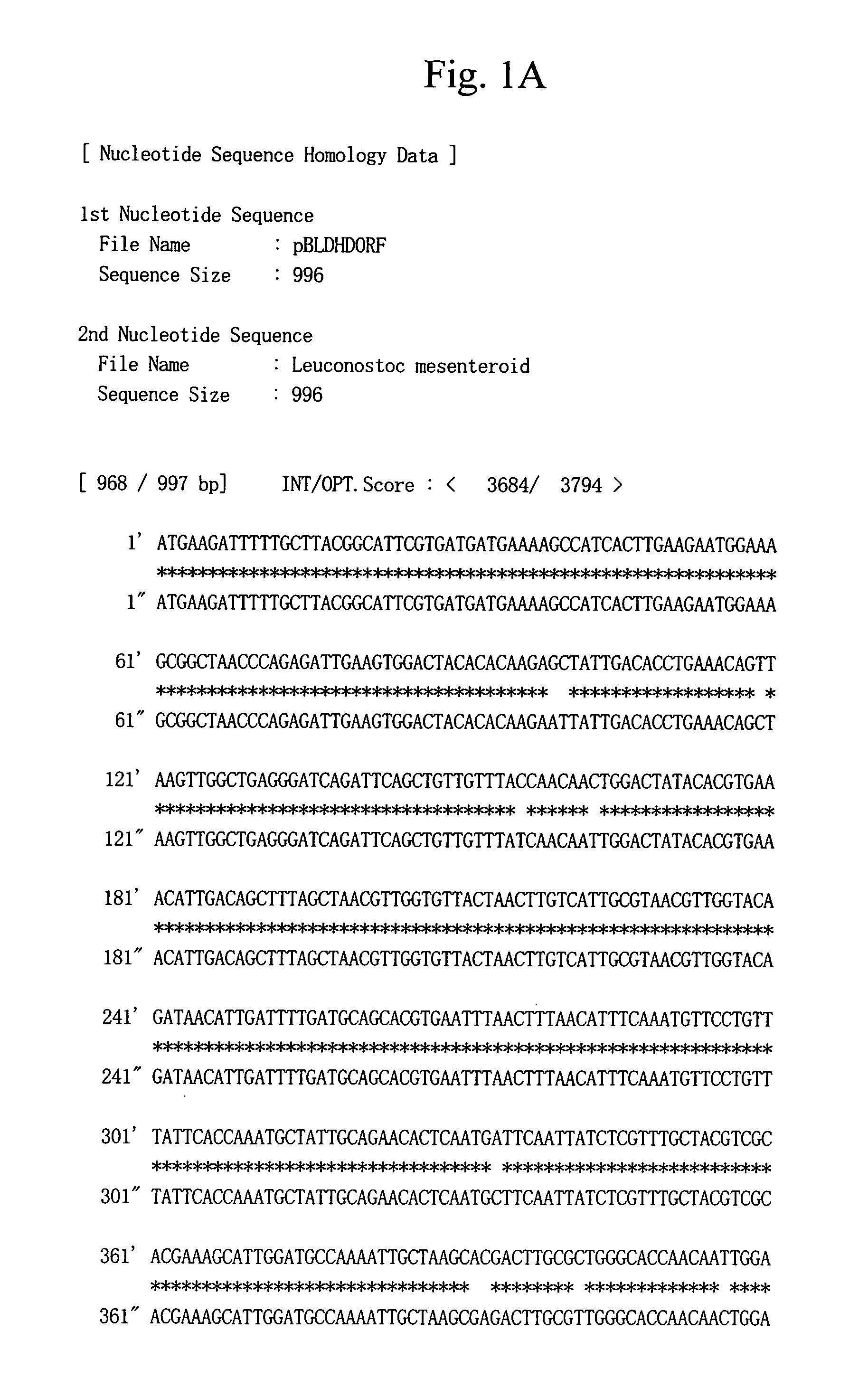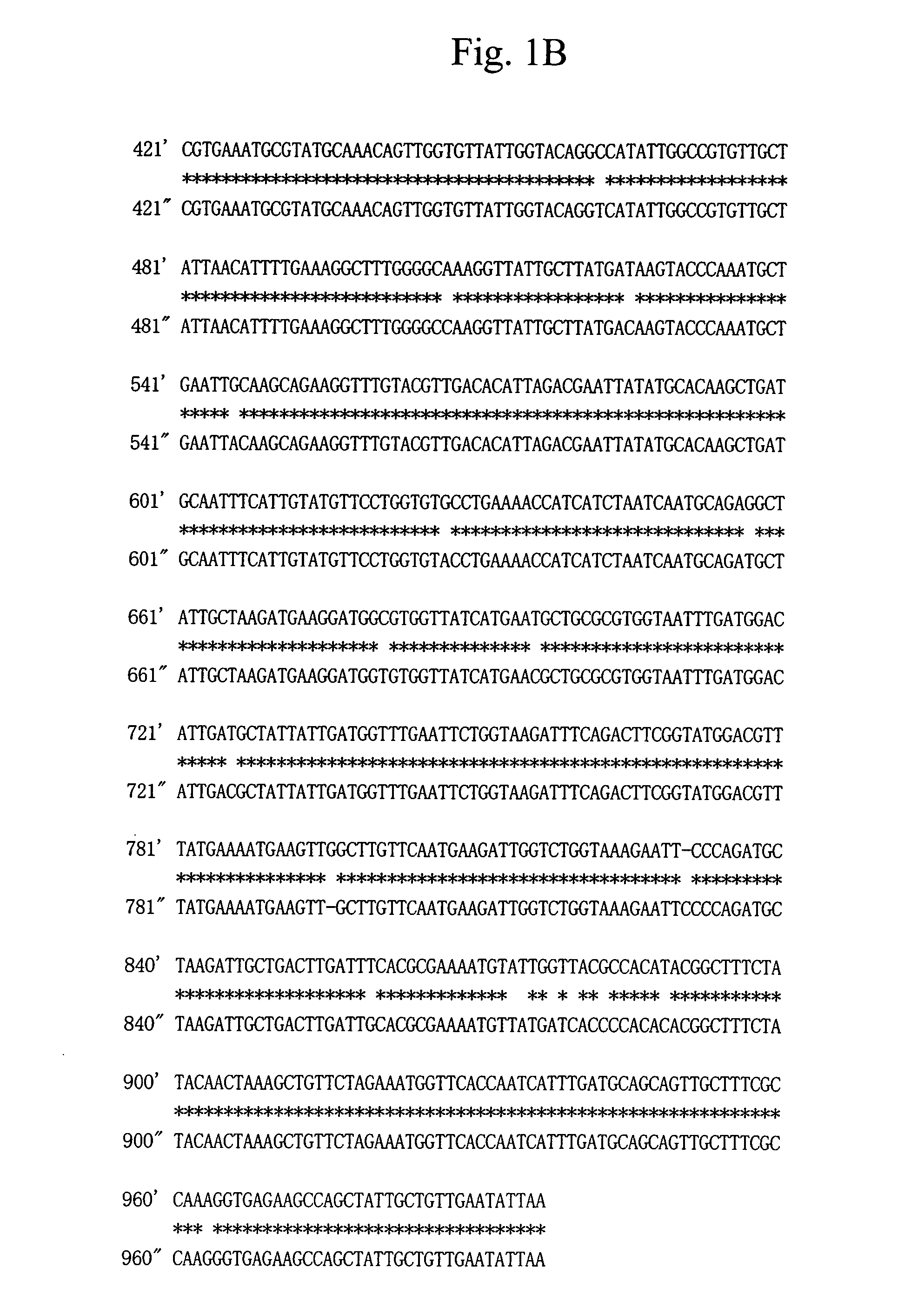Dna encoding a protein having d-lactate dehydrogenase activity and uses thereof
a technology of dlactate dehydrogenase and dna encoding, which is applied in the field of dlactic acid, can solve the problems that microorganisms capable of producing lactic acid have not been suitable for industrial production of lactic acid, and achieve the effect of positively affecting the production of d-lactic acid and excellent capacity for producing d-lactic acid
- Summary
- Abstract
- Description
- Claims
- Application Information
AI Technical Summary
Benefits of technology
Problems solved by technology
Method used
Image
Examples
example 1
Isolation of D-Lactate Dehydrogenase Gene
[0134] The D-lactate dehydrogenase genes derived from prokaryotic lactic acid bacteria, Leuconostoc mesenteroides (D-LDH genes, hereafter they may be simply referred to as “D-LDHME genes”), were isolated.
[0135] The genomic DNA of the strain IFO3426 (registered with the Institute for Fermentation) was used as a template to isolate the gene resource via PCR amplification. The genomic DNA of this strain was prepared using a genome DNA preparation kit (Fast DNA Kit, Bio 101) in accordance with the protocol included with the kit. The prepared genomic DNA was subjected to DNA concentration measurement using the Ultrospec 3000 spectrophotometer (Amersham Pharmacia Biotech).
[0136] The KOD Plus DNA Polymerase (Toyobo Co., Ltd.), which is perceived as having high accuracy, was used as the amplification enzyme in PCR. The reaction solution (50 μl in total) comprising 50 ng of the previously prepared genomic DNA, 50 pmol of ×2 primer DNA, 5 μl of 10× ...
example 2
Construction of Recombinant Vector
[0148] A chromosomally integrated vector capable of expressing a target gene, i.e., the D-LDHME gene obtained in Example 1, was constructed. This vector is capable of expressing the target gene under the control of the promoter sequence of the pyruvate decarboxylase 1 gene (PDCI) derived from Saccharomyces cerevisae. Such newly constructed and chromosomally integrated vector was designated as the pBTRP-PDC1-DLDHME vector. Construction of the vector was carried out in accordance with the general technique for DNA subcloning.
[0149] Hereafter, the process of vector construction in the present example is described in detail with reference to FIGS. 3 to 6.
[0150] All the enzymes used for vector construction were manufactured by Takara Shuzo Co., Ltd. It should be noted that the possible vector construction processes are not limited to this process.
1. Isolation of a Promoter Fragment of the PDC1 Gene (PDC1P) and a Downstream Fragment of the PDC1 gene ...
example 3
Transformation of Yeast
[0164] The yeast host strain IFO2260 (registered with the Institute for Fermentation) lacking the capacity for tryptophan synthesis was cultured in 10 ml of YPD medium at 30° C. until the logarithmic growth phase, and cells were collected and washed with TE buffer. Subsequently, 0.5 ml of TE buffer and 0.5 ml of 0.2 M lithium acetate were added, the resultant was subjected to shake culture at 30° C. for 1 hour, and pBTRP-PDC1-DLDHME that had been processed with the ApaI and SpeI restriction enzymes (Takara Shuzo Co., Ltd.) was then added.
[0165] The resulting suspension was subjected to shake culture at 30° C. for 30 minutes, 150 μl of 70% polyethylene glycol 4000 (Wako Pure Chemical Industries, Ltd.) was added thereto, and the mixture was thoroughly stirred. The resultant was further subjected to shake culture at 30° C. for 1 hour, the culture product was treated with a heat shock of 42° C. for 5 minutes, and the cells were then cultured in 1 ml of YPD cultu...
PUM
| Property | Measurement | Unit |
|---|---|---|
| temperature | aaaaa | aaaaa |
| temperature | aaaaa | aaaaa |
| temperature | aaaaa | aaaaa |
Abstract
Description
Claims
Application Information
 Login to View More
Login to View More - R&D
- Intellectual Property
- Life Sciences
- Materials
- Tech Scout
- Unparalleled Data Quality
- Higher Quality Content
- 60% Fewer Hallucinations
Browse by: Latest US Patents, China's latest patents, Technical Efficacy Thesaurus, Application Domain, Technology Topic, Popular Technical Reports.
© 2025 PatSnap. All rights reserved.Legal|Privacy policy|Modern Slavery Act Transparency Statement|Sitemap|About US| Contact US: help@patsnap.com



